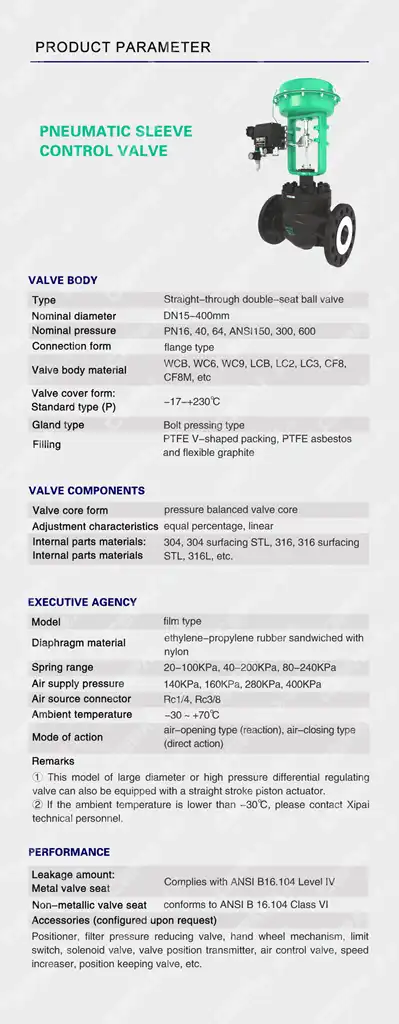Understanding Control Valve Fundamentals
Control Valve Components and Operation
Control valves are complex devices comprising several key components that work together to regulate fluid flow. The main parts include the valve body, trim, actuator, and positioner. The valve body houses the internal components and provides the connection to the process piping. The trim, consisting of the plug and seat, is responsible for controlling the flow by varying the flow area. The actuator, which can be pneumatic, hydraulic, or electric, provides the motive force to position the valve stem. The positioner ensures accurate valve positioning by comparing the desired setpoint with the actual valve position and making necessary adjustments.
Types of Control Valves
There are various types of control valves designed for specific applications and operating conditions. Globe valves are widely used for general flow control due to their versatility and excellent throttling characteristics. Ball valves offer quick operation and tight shutoff, making them suitable for on-off applications. Butterfly valves are lightweight and compact, ideal for large diameter pipes. Diaphragm valves excel in handling corrosive or sanitary fluids. Understanding the strengths and limitations of each valve type is crucial for selecting the most appropriate option for a given process.
Control Valve Characteristics and Sizing
Control valve characteristics refer to the relationship between valve opening and flow rate. Common characteristics include linear, equal percentage, and quick opening. Proper valve sizing is critical to ensure optimal performance and avoid issues such as cavitation, flashing, or noise. Factors to consider when sizing a control valve include flow coefficient (Cv), pressure drop, fluid properties, and rangeability. Utilizing advanced sizing software and consulting with valve manufacturers can help engineers determine the most suitable valve size and trim configuration for their specific application.
Advanced Control Valve Technologies and Strategies
Smart Positioners and Diagnostics
Smart positioners have revolutionized control valve operation by incorporating advanced electronics and communication capabilities. These devices offer precise valve positioning, self-calibration, and real-time diagnostics. By continuously monitoring valve performance parameters such as travel, cycle count, and friction, smart positioners enable predictive maintenance strategies, reducing unexpected downtime and optimizing maintenance schedules. Some advanced positioners even incorporate machine learning algorithms to detect anomalies and predict potential failures before they occur.
Digital Valve Controllers and Fieldbus Integration
Digital valve controllers represent the next evolution in control valve technology, offering enhanced functionality and integration with modern control systems. These controllers support various communication protocols, such as HART, Foundation Fieldbus, and Profibus, allowing seamless integration with distributed control systems (DCS) and asset management platforms. This integration enables remote monitoring, configuration, and diagnostics of control valves, improving operational efficiency and reducing the need for field visits. Additionally, digital valve controllers facilitate advanced control strategies like cascade control and feed-forward control, enhancing overall process performance.

Noise Reduction and Cavitation Control
Noise and cavitation are common challenges in control valve applications, particularly in high-pressure drop scenarios. Advanced trim designs, such as multi-stage trims and anti-cavitation cages, help mitigate these issues by gradually reducing pressure and controlling flow patterns. Noise-abatement trims utilize specially designed flow paths to attenuate aerodynamic noise generated by turbulent flow. For severe service applications, hardened materials like tungsten carbide or ceramic can be employed to withstand the erosive effects of cavitation. Implementing these technologies not only improves process control but also extends valve life and reduces maintenance costs.
Optimizing Control Valve Performance and Maintenance
Control Valve Tuning and Loop Optimization
Proper control valve tuning is crucial for achieving optimal process control. This involves adjusting parameters such as gain, integral time, and derivative time to ensure the valve responds accurately and promptly to setpoint changes. Advanced tuning methods, like model-based tuning and adaptive control algorithms, can significantly improve loop performance by automatically adjusting control parameters based on process dynamics. Regular loop performance monitoring and analysis help identify and address issues such as valve stiction, hysteresis, or oversizing, which can negatively impact control quality.
Preventive Maintenance Strategies
Implementing a robust preventive maintenance program is essential for maximizing control valve reliability and longevity. This includes regular inspections, lubrication, and replacement of wear parts such as packing and gaskets. Utilizing condition monitoring techniques, such as acoustic emission analysis and thermography, can help detect potential issues before they lead to valve failure. Establishing a comprehensive spare parts inventory and standardizing valve components across the plant can minimize downtime during maintenance activities. Additionally, proper documentation of maintenance history and performance trends enables data-driven decision-making for valve replacement or upgrade.
Valve Refurbishment and Upgrade Considerations
As control valves age or process requirements change, refurbishment or upgrade may become necessary. Valve refurbishment involves disassembling, inspecting, and reconditioning valve components to restore original performance. This can be a cost-effective alternative to replacement, particularly for large or specialized valves. When considering upgrades, factors such as improved materials, advanced trim designs, or smart positioners should be evaluated based on their potential to enhance process control, reduce maintenance costs, or improve efficiency. Conducting a thorough cost-benefit analysis, considering both short-term and long-term impacts, helps determine the most appropriate course of action for each control valve in the system.
Conclusion
Mastering control valves in process control is a multifaceted endeavor that requires a deep understanding of valve principles, advanced technologies, and maintenance strategies. By implementing the insights and best practices outlined in this guide, process engineers and operators can optimize their control valve performance, enhance overall process efficiency, and reduce operational costs. As technology continues to evolve, staying informed about the latest developments in control valve design and automation will be crucial for maintaining a competitive edge in today's demanding industrial landscape.
Contact Us
Ready to optimize your process control with cutting-edge valve solutions? Contact CEPAI Group today to explore our range of high-performance control valves, smart positioners, and expert consultation services. Benefit from our extensive experience in oil and gas, chemical processing, and manufacturing industries. Email us at cepai@cepai.com to discuss how we can enhance your operations and drive sustainable growth for your business.


_1746598531170.webp)



